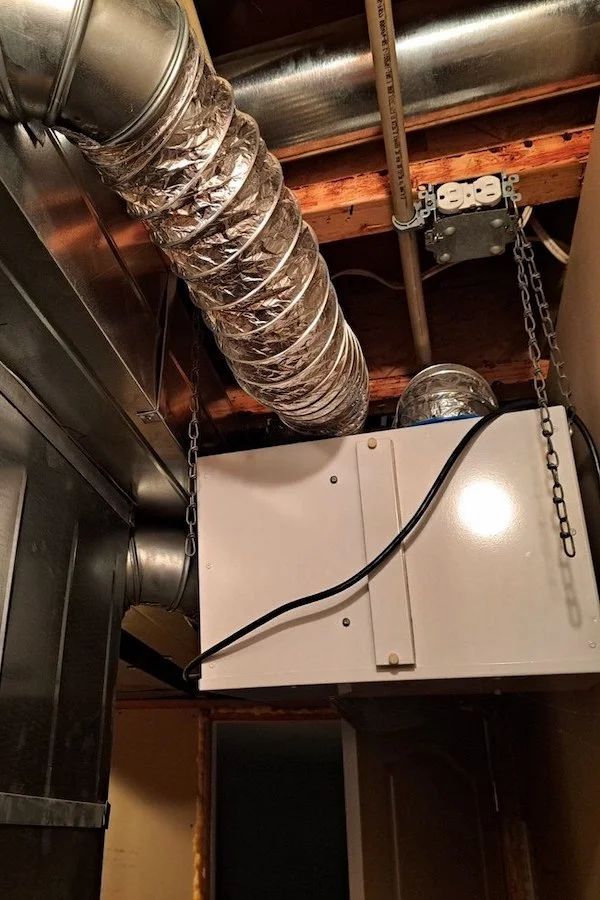What Is an Energy Recovery Ventilator?

Introduction to Energy Recovery Ventilators

An energy recovery ventilator (ERV) is a mechanical ventilation system that exchanges stale indoor air with fresh outdoor air while transferring both heat and moisture to improve energy efficiency and indoor air quality.
Unlike traditional ventilation systems, an energy recovery ventilator minimizes energy loss by recovering up to 85% of the heat and humidity from the outgoing air, making it ideal for tightly sealed homes.
In modern residences, an energy recovery ventilator is crucial for maintaining healthy air quality, reducing pollutants, allergens, and excess humidity that can lead to mold growth.
How Does an ERV Differ from Other Ventilation Systems?

An energy recovery ventilator stands out by transferring both heat and moisture, unlike a heat recovery ventilator (HRV), which only transfers heat, making ERVs better suited for humid climates.
Compared to exhaust-only systems, an energy recovery ventilator provides balanced ventilation, ensuring equal air intake and exhaust to maintain indoor air pressure.
The ability to control humidity makes an energy recovery ventilator particularly valuable in regions with extreme seasonal variations, like the humid summers and dry winters of Quebec.
What Is an ERV in HVAC?
Defining ERV in the HVAC Context

What is an ERV in HVAC? In heating, ventilation, and air conditioning systems, an ERV is a device that enhances air quality while recovering energy, integrating seamlessly with HVAC setups to optimize comfort.
An energy recovery ventilator works alongside furnaces or air conditioners, preconditioning incoming air to reduce the workload on these systems, thus lowering energy costs.
In HVAC applications, an energy recovery ventilator is often installed in homes or commercial buildings to meet ventilation codes while maintaining energy efficiency standards like ENERGY STAR.
Components of an Energy Recovery Ventilator

The core of an energy recovery ventilator is its enthalpy wheel or membrane, which transfers heat and moisture between incoming and outgoing air streams without mixing them.
Dual fans in an energy recovery ventilator ensure balanced airflow, drawing in fresh air and expelling stale air through separate ducts for continuous ventilation.
Filters within an energy recovery ventilator capture dust, pollen, and other particles, protecting both the system and indoor air quality from contaminants.
- Choose an energy recovery ventilator with high-efficiency filters, such as HEPA, for allergy-prone households.
- Ensure the ERV is sized correctly for your home’s square footage to avoid over- or under-ventilation.
- Opt for models with quiet fans, ideally under 1.5 sones, for minimal noise disruption.
- Check for ENERGY STAR certification to qualify for rebates on your energy recovery ventilator.
- Regular maintenance of the enthalpy wheel ensures optimal energy recovery ventilation performance.
What Is a Heat Recovery Ventilator?
Comparing ERV and HRV

What is a heat recovery ventilator? An HRV transfers only heat between air streams, making it ideal for cold, dry climates like much of Canada, where humidity control is less critical.
Unlike an energy recovery ventilator, an HRV does not manage moisture, which can lead to overly dry indoor air in winter or excessive humidity in summer.
Choosing between an HRV and an energy recovery ventilator depends on your climate; ERVs are better for humid regions, while HRVs suit drier environments.
What Does a Heat Recovery Ventilator Do?

What does a heat recovery ventilator do? An HRV extracts heat from stale indoor air and transfers it to incoming cold air, reducing heating costs in winter without adding moisture.
An energy recovery ventilator, by contrast, also controls humidity, preventing overly dry air in winter or overly humid air in summer, enhancing comfort.
While an HRV focuses solely on temperature regulation, an energy recovery ventilator offers a more comprehensive solution for year-round air quality and energy savings.
What Is Energy Recovery Ventilation?
The Process of Energy Recovery Ventilation

What is energy recovery ventilation? It’s the process of exchanging indoor and outdoor air while transferring heat and moisture to minimize energy loss and maintain indoor comfort.
In an energy recovery ventilator, the enthalpy wheel rotates between air streams, absorbing heat and humidity from one and releasing it to the other, ensuring efficiency.
This process in an energy recovery ventilator reduces the energy needed to heat or cool incoming air, saving up to 20% on HVAC costs compared to standard ventilation.
Benefits of Energy Recovery Ventilation

An energy recovery ventilator improves indoor air quality by reducing pollutants like CO2, VOCs, and allergens, creating a healthier living environment.
By recovering energy, an energy recovery ventilator lowers utility bills, with some models achieving up to 90% heat recovery efficiency in optimal conditions.
The humidity control of an energy recovery ventilator prevents mold growth and maintains comfortable indoor moisture levels, especially in humid climates.
Applications and Suitability
Residential Use

In homes, an energy recovery ventilator is ideal for tightly sealed, energy-efficient buildings where natural ventilation is limited, preventing stale air buildup.
For families with allergies, an energy recovery ventilator with HEPA filters removes fine particles, improving respiratory health and comfort.
Modern homes in Quebec benefit from an energy recovery ventilator to balance ventilation needs with energy conservation during harsh winters and humid summers.
Commercial and Industrial Applications

In offices, an energy recovery ventilator ensures fresh air for employees, reducing sick building syndrome while maintaining energy efficiency in large spaces.
Restaurants and gyms use an energy recovery ventilator to manage high humidity and odors, ensuring a pleasant environment without excessive HVAC costs.
Industrial facilities rely on an energy recovery ventilator to ventilate large areas while recovering energy, meeting strict building codes and sustainability goals.
Choosing the Best ERV
What Is the Best Energy Recovery Ventilator?

The best energy recovery ventilator, such as the Panasonic Intelli-Balance 100, offers high efficiency (up to 93% heat recovery) and quiet operation at 0.8 sones.
Brands like Venmar AVS E15 provide durable enthalpy cores and smart controls, making them a top choice for the energy recovery ventilator in cold climates.
Fantech’s SER series, with advanced humidity control, is considered the best energy recovery ventilator for humid regions, offering robust performance and easy maintenance.
Factors to Consider When Selecting an ERV

Choose an energy recovery ventilator with a capacity suited to your home’s size, typically 50-200 CFM for residences, to ensure effective ventilation.
Look for models with smart controls, like those from Lifebreath, which allow remote adjustments and optimize the energy recovery ventilator for energy savings.
Ensure the energy recovery ventilator has a warranty of at least 5 years on the core and 2 years on parts to protect your investment.
Installation and Maintenance
Professional Installation

Installing an energy recovery ventilator requires a professional to ensure proper ductwork, balanced airflow, and compliance with local building codes.
Improper installation of an energy recovery ventilator can lead to air leaks or reduced efficiency, increasing energy costs and compromising air quality.
Installation costs for an energy recovery ventilator range from $2,000 to $5,000, depending on the complexity and size of the system.
Maintenance Requirements

Clean or replace the filters of an energy recovery ventilator every 3-6 months to prevent clogs and maintain air quality.
Inspect the enthalpy core of an energy recovery ventilator annually, cleaning it with mild soap and water to remove dust and ensure efficiency.
Schedule professional maintenance for an energy recovery ventilator every 2-3 years to check fans, ducts, and controls for optimal performance.
Energy Recovery Ventilator in Winter
Operation in Cold Climates

An energy recovery ventilator is essential in winter to prevent humidity buildup in sealed homes, reducing the risk of mold and maintaining air quality.
In cold climates, an energy recovery ventilator recovers heat from outgoing air, reducing heating costs by up to 15% compared to exhaust-only systems.
Some models of an energy recovery ventilator include a preheater to prevent core freezing in sub-zero temperatures, ensuring reliable operation.
Adjusting Settings for Winter

Set the energy recovery ventilator to a moderate ventilation rate in winter to balance air exchange with heat retention, avoiding over-drying indoor air.
Monitor humidity levels with the energy recovery ventilator’s built-in sensors to maintain 30-50% relative humidity for comfort and health.
Clear snow or ice from the energy recovery ventilator’s exterior vents to ensure unobstructed airflow during harsh winter conditions.
Cost and Incentives
Cost of an Energy Recovery Ventilator

An energy recovery ventilator costs between $1,500 and $4,000 for the unit, with additional installation fees depending on ductwork complexity.
High-efficiency models like the Fantech VHR 2005R reduce long-term energy costs, offering a return on investment within 5-7 years for an energy recovery ventilator.
Maintenance costs for an energy recovery ventilator are minimal, typically $100-$200 annually for filter replacements and professional servicing.
Available Incentives

Hydro-Quebec offers rebates up to $1,000 for installing an ENERGY STAR-certified energy recovery ventilator in Canada.
In the US, federal tax credits through 2025 can cover up to 30% of the cost of an energy recovery ventilator, capped at $600, under the Inflation Reduction Act.
Check local utility programs for additional incentives to offset the initial cost of an energy recovery ventilator, making it more affordable.
Conclusion: Enhancing Home Comfort with an ERV
Why Invest in an ERV?

Understanding what is an energy recovery ventilator helps you appreciate its role in improving air quality and reducing energy costs year-round.
An energy recovery ventilator is a smart investment for modern homes, offering health benefits, comfort, and sustainability in one system.
By choosing the best energy recovery ventilator and maintaining it properly, you ensure a healthier, more efficient home for years to come.

Understanding Energy Recovery Ventilators for Better Home Ventilation +1 (819) 485 0516
What Is an Energy Recovery Ventilator?

Nous offrons des services complets de CVC à Gatineau, Québec, spécialisés dans le chauffage, la climatisation, les thermopompes et les échangeurs d’air pour des projets résidentiels et commerciaux. hvacgatineau@outlook.com


Contactez-nous
HVAC Gatineau Services de Chauffage, Climatisation et Ventilation
Si vous recherchez des solutions CVC de qualité près de chez vous, notre équipe d’experts chez HVAC Gatineau vous garantit des résultats durables pour l’installation, la réparation et l’entretien de systèmes de chauffage, climatisation, thermopompes et échangeurs d’air. Nous servons Gatineau, Hull, Aylmer, Buckingham, Masson-Angers et les environs. Contactez-nous pour un devis rapide sur vos besoins en CVC à Gatineau et dans les environs.

